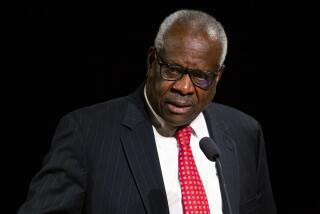Judge to Guide Indian Trust Fund Reform
- Share via
WASHINGTON — Branding the government’s century-old mismanagement of Indian trust fund money as “inexcusable,” a federal judge pledged Tuesday to oversee reform of a program that will pay thousands of Native Americans as much as $2.5 billion in royalties that are due them.
In a final ruling in the long-running case, U.S. District Judge Royce C. Lamberth reiterated his condemnation of Interior and Treasury Department officials for what he called decades of mishandling the trust accounts. But the judge expressed frustration that reconciling the system for as many as 500,000 claimants defies easy solution.
Capping the largest class-action lawsuit in history against the federal government, Lamberth rejected the pleas of Native American plaintiffs for a court-appointed “special master” to supervise changes in the antiquated trust system. Instead, he said, he would credit the sworn promises of Interior Secretary Bruce Babbitt to begin a step-by-step cleanup. But the judge will require quarterly progress reports from Interior and the Bureau of Indian Affairs, one of its divisions, for as long as five years.
The trust funds, which affect Native Americans in every state west of the Mississippi River, were established in the 1830s during the administration of President Andrew Jackson. They were part of a government effort to compensate individuals for use of their land while weakening tribal control of valuable assets.
The trust fund records are in such disarray, Lamberth said, that while many Native Americans have been receiving payments “it is entirely possible that tens of thousands of trust beneficiaries should be receiving different amounts of money--their own money--than they do today.
“But no one can say, which is the crux of the problem,” the judge added.
The Interior Department responded in a joint statement with Treasury that “we are gratified” by Lamberth’s decision to allow the government “an opportunity to move forward” and implement a plan to reform trust fund management.
“We are determined to meet the challenges and overcome obstacles that lie ahead, and we welcome the continued oversight from the court,” said the statement from Babbitt’s office.
As to compensation for past government mismanagement, Lamberth said that he would preside at a second trial, perhaps starting next fall, at which attorneys for Native American plaintiffs will present conclusions of an outside accounting firm on the identities of 300,000 to 500,000 Native Americans who should have received some payments or additional sums.
Unless Interior officials can rebut the claims of PricewaterhouseCoopers accountants, who have investigated the system for more than three years, Lamberth is expected to order back payments to these plaintiffs. The judge has said that $2.5 billion may have been mismanaged.
“We will be in the catbird seat,” said Elliott H. Levitas, a leading plaintiff lawyer and former congressman. “The problem for the government [in rebutting such claims] is they don’t have the records.”
Eloise Cobell, lead plaintiff in the 3-year-old lawsuit, said that she is delighted with Lamberth’s ruling. Cobell said many officials fail to understand that some impoverished residents of the Blackfeet Indian reservation in Montana, where she lives, are heavily dependent on U.S. payments for support of their families.
Most of those affected in California are members of the Hoopa and Klamath tribes in the northern part of the state.
However, based on the success of this lawsuit, hundreds of tribes with so-called tribal accounts--as opposed to individual accounts, the subject of the current suit--are prepared to follow up with a similar class-action complaint.
Keith Harper, attorney for the Native American Rights Fund, which organized the lawsuit, said that these tribes include “dozens all throughout Southern California.”
Federal officials are supposed to manage the accounts and pass along royalties from the sale of petroleum, timber and other natural resources. The government says that it has deposited between $350 million and $500 million a year for decades into the accounts. But months of testimony in Lamberth’s courtroom showed that officials have been unable to give an accounting of where all the money has gone, citing damage to old documents and an outmoded record system.
The bulk of the records in dispute have been in possession of the Interior Department, with Treasury acting as banker. Lamberth earlier this year held Babbitt and Robert E. Rubin, then Treasury secretary, in contempt of court, saying that they showed “flagrant disregard” for his orders to furnish key records to the plaintiffs.
Harper said that he is pleased the judge held open the possibility of appointing a special master at a later date should his own supervision of trust fund reform prove too burdensome.
Earlier this month, Lamberth disclosed that government clerks destroyed 162 boxes of records a year ago but Treasury Department lawyers concealed it from the court for three months, even after halting the routine shredding of old files.
The judge said Tuesday that such evidence is “cumulative” in reflecting federal mishandling of Indian files and that he would impose no additional sanctions.
In October, Lamberth ordered both sides in the lawsuit to pursue arbitration by an independent law professor, but the effort failed to result in an agreement.
“Generations of trust beneficiaries have been born and raised with the assurance that their trustee, the United States, was acting properly with their money,” the judge said in his opinion. “Just as many generations have been denied any such proof, however.”
More to Read
Sign up for Essential California
The most important California stories and recommendations in your inbox every morning.
You may occasionally receive promotional content from the Los Angeles Times.













